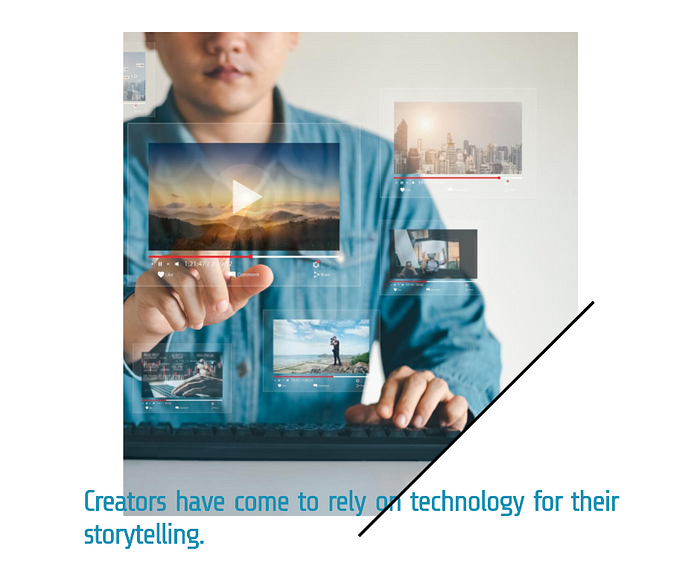Creating Captivating Content: The Fusion of Art and Craft with Generative Adversarial Networks
Harnessing the power of GANs, today’s content creators unlock a world of possibilities. These innovative networks enable the generation of visually stunning and immersive experiences, breathing life into stories and captivating audiences in unprecedented ways.

In the ever-evolving digital era, the notion of content has transcended its traditional confines, embracing a vast array of mediums and technologies. The convergence of technology, hardware, software, codes, algorithms, and data models with traditional content has forged a dynamic and influential force that propels our society forward.
The definition of content has experienced an unprecedented expansion, liberating itself from conventional limitations. No longer confined to writing, photography, or graphic design, content now encompasses an extensive spectrum of media and cutting-edge technologies. From immersive virtual reality experiences and interactive websites to the realms of podcasting, video streaming, and beyond, the possibilities are boundless. Today, content manifests as a dynamic and ever-evolving entity, consistently pushing the frontiers of creativity and innovation.
In our interconnected digital landscape, content serves as a catalyst for fostering innovation, nurturing creativity, and enabling collaboration.
At the same time, the contribution of technology cannot be ignored. Tech plays a pivotal role in reshaping the content creation landscape. Cutting-edge hardware, software, and sophisticated algorithms have revolutionized how we create, consume, and interact with content.
Content Creators From Around the World! Join Our LinkedIn Group

This Group is for
(a) content providers
(b) wannabe content providers
© content agencies
(d) content clients
(e) marketers
(f) advertisers
(g) data specialists
(h) gamers
(i) assorted content lovers
We look at content from all 6 sides of the prism, including from the point of view of the provider and the receiver. So hop on to one of the thriving communities around content.
- Be Involved, Be Informed -
Click here to join.
In the realm of content creation, technology emerges as a formidable ally, empowering creators to elevate their storytelling prowess, curate personalized experiences, and captivate audiences like never before. From data-driven content strategies to AI-powered creation, technology seamlessly integrates into the content ecosystem, assuming a vital role in its evolution.
As we embrace the transformative power of technology in content creation, we embark on a journey through an ever-evolving landscape. Here, innovation flourishes, creativity thrives, and collaboration blooms. By navigating this dynamic terrain, we uncover new avenues for expression, harness cutting-edge tools, and discover the infinite possibilities that arise at the intersection of technology and content creation. Join us as we explore this exciting frontier, where technology unlocks unprecedented potential for creators to shape narratives, engage audiences, and push the boundaries of storytelling.
And why am I telling you all this? Because of today’s topic — Generative Adversarial Network (GAN), which is a hot subject these days in the worlds of artificial intelligence and neural networks.
Now, before the traditional content developers/creators among you switch off, let me just gently remind them of the need to keep an open mind and to try and embrace the endless possibilities that this particular piece of technology brings to the content table. After all, if this tech did not exist, we would never have been able to generate those incredibly realistic images, videos, and even 3D models across multiple industries.
GANs, as I have come to realize, are a fascinating world, and like generative AI (of ChatGPT fame), are being used extensively in content creation.
Subscribe To Our Newsletter “All About Content”
Deepfakes! Perhaps the most famous example of the use of GANs and something that readers can easily identify with.
In 2018, when a deepfake video featuring former US President Barack Obama was created by BuzzFeed and filmmaker Jordan Peele, somewhere in the back-end, a GAN was at work.
Here’s a short list of other things you may have encountered in the real world which are the work of GANs:
- Old black and white photos, which are now colored
- Anime images
- The creation of emojis from text
- Making “noise” (color fluctuation) free images
- Creation of a brand-new image that replicates the style of another
- Aging, “de-aging” of human faces
- Generation of 3D images
- Creation of whole new video scenes which were never shot to begin with
- Creation of virtual influencers
I could go and on. For those of you who want to know more, here’s an excellent post on the applications of GAN.
The point I make is that since their introduction around 2014, GANs have been steadily gaining popularity. Every day, they present content creators with expanding opportunities and untapped potential.
Before going further, let’s just quickly understand what GANs mean.
What are Generative Adversarial Networks?
Generative Adversarial Networks, or GANs, are a type of neural network architecture used for generative modeling. For the uninitiated, a neural network is a method in AI that helps computers learn and process information, similar to how the human brain work. It’s a type of machine learning called deep learning, where computers use interconnected nodes or neurons arranged in layers, just like the structure of our brains. This allows computers to understand and make sense of complex data in a more human-like way.
What’s So Great About Generative Adversarial Networks?
The thing is GANs have become popular because they have revolutionized the field of synthetic data generation. Because of this ability, creators have started to use them to develop images, videos, 3D objects, and so forth.
A quick primer on synthetic data: It’s nothing but information that’s lab manufactured and not from the real world. An example would be creating data to understand the after-effects of a car crash. Obviously, crashing real cars would be tremendously expensive for an auto manufacturer and maybe a wee bit dangerous. So they resort to using synthetic data, which, in turn, is fed into the system, following which GANs are used to create highly realistic images, videos, and 3D objects of cars and passengers. The same like with deepfakes where it is not the real Tom Cruise or Morgan Freeman talking to you in that video clip.
So you see, GANs have opened up a world of possibilities for various industries, ranging from entertainment to healthcare. For instance, this technology can be used to create new video game characters, design fashion items, or even produce synthetic medical images for training purposes. Why, it can be used to make products look better, and in the case of personal clothing, allow potential customers to try on the clothes first digitally before purchase online.
I will not go into how GANs work but focus on their use in content creation. One of the most successful implementations of GAN is the Deep Convolutional GAN (DCGAN). This is the hero software that is being used extensively in various applications, including image generation, video prediction, and 3D object generation. From photo inpainting to clothing translation, DCGANs have been applied to solve many problems, paving the way for new opportunities in multiple industries.
Given Below are the Many Applications of GANs
Creating Realistic Images
GANs can generate remarkably realistic images of landscapes, animals, human faces, and more. These images can be used to augment existing image datasets or create entirely new ones for various applications, including machine learning and computer vision tasks.
Enhancing and Editing Images
Another interesting application of GANs is image enhancement and editing. GANs can be used to improve the quality of low-resolution images, fill in missing or damaged parts of pictures, or even change the background of an image. This makes GANs a powerful tool for professional photographers and graphic designers.
Generating Artistic Images
GANs have also found a place in the realm of digital art. Artists can use GANs to generate unique and visually stunning pieces of art. In fact, a portrait produced by a GAN was sold at auction for $432,500 in 2018, marking a significant milestone for AI-generated art.
Generating Text with Generative Adversarial Networks
Text Generation Techniques
GANs can also be used for text generation tasks. For example, they can be employed to write poems, stories, or even entire novels. GANs can also generate realistic chat responses, making them useful for developing chatbots and virtual assistants.
Generating Natural Language Text
One of the challenges in natural language processing is generating text that is coherent and semantically meaningful. GANs have shown promise in this area, being able to generate sentences that are grammatically correct and contextually relevant.
Generating Creative Writing
In the field of creative writing, GANs can serve as a valuable tool for writers. They can generate novel ideas, suggest plot twists, or even help with character development. While they cannot replace human creativity, they can certainly enhance it and make the writing process more efficient.
Generating Audio with Generative Adversarial Networks
Music Composition
GANs have also been used in music composition. They can generate new melodies, harmonies, or even complete compositions, opening up new possibilities for musicians and composers. GANs can also be used to create personalized music, tailoring songs to individual listeners’ preferences.
Speech Synthesis
Another interesting application of GANs is speech synthesis. They can be used to generate human-like speech, which can be particularly useful in developing voice assistants and other speech-enabled technologies. GANs can even mimic specific voices, making them useful in post-production for movies and TV shows.
Advanced Techniques and Applications
Style Transfer
Style transfer is an exciting application of GANs, where the style of one image is transferred to another. This can be used to convert photos into paintings, apply filters, or even change the season or weather in an image.
Video Generation
GANs can also be used for video generation tasks, such as creating new video clips, animating static images, or even predicting future frames in a video. This opens up new possibilities for video editing, special effects, and virtual reality applications.
In short, here’s what you can do with GANs:
- Create anime characters
- Create high-resolution images of virtual fashion models wearing customizable outfits
- Change poses of models
- Create images
- Image style transfer
- Color old black and white photos and videos
- Remove unwanted noise from real scenes
- Summarize text
- Create new, realistic-looking product images that can be used for e-commerce or advertising
Industries and sectors already using GANs
- Fashion
- Ecommerce
- Medicine
- Advertising and Marketing
- Film Making
- Podcasting
- Gaming
- Education
- Architecture
Subscribe to Our YouTube Channel

Final Thoughts on Generative Adversarial Networks for Content Creation
Generative Adversarial Networks offer fascinating possibilities for content creators to use their ability to generate realistic images, text, and audio. The tech has been successfully applied in various fields, including image generation, text generation, music composition, and more. Slowly but surely, without many of us even being aware of it, GANs have started changing the way we create and interact with digital content.
